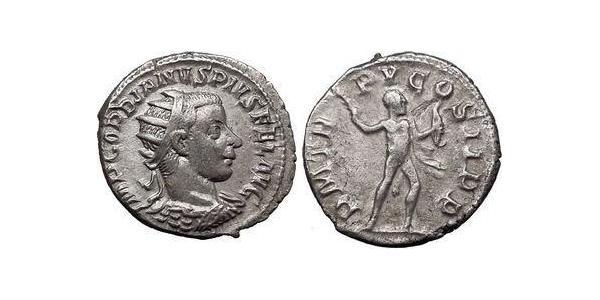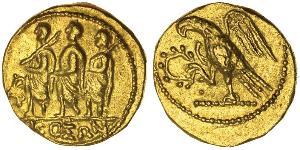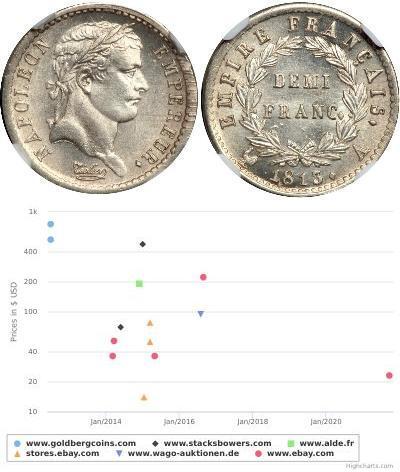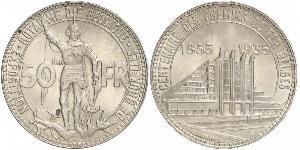[ 4608] GORDIAN III - Roman Emperor: 238-244 A.D. - Silver Antoninianus (23mm, 4.75gm.) Antioch, 242-243 A.D. References: RIC 206 C. 264 Aukt. Helios 1 (2008), No. 506 IMP GORDIANVS PIVS FEL AVG. radiate cuirassed bust right with slight mustache to right. P M TR P V COS II P P Hercules attacking right with club and bow, nude apart from lion-skin hanging over left shoulder. Provided with certificate of authenticity. CERTIFIED AUTHENTIC by Sergey Nechayev, PhD - Numismatic Expert Hercules is the the Roman name for the mythical Greek demigod Heracles, son of Jupiter (the Roman equivalent of Zeus), and the mortal Alcmena. Early Roman sources suggest that the imported Greek hero supplanted a mythic Italic shepherd called "Recaranus" or "Garanus", famous for his strength, who dedicated the Ara Maxima that became associated with the earliest Roman cult of Hercules. While adopting much of the Greek Heracles' iconography and mythology as his own, Hercules adopted a number of myths and characteristics that were distinctly Roman. With the spread of Roman hegemony, Hercules was worshiped locally from Spain through Gaul. Hercules's Latin name is not directly borrowed from Greek Heracles but is a modification of the Etruscan name Hercle, which derives from the Greek name via syncope, Heracles translates to "The Glory of Hera". An oath invoking Hercules (Hercle! or Mehercle!) was a common interjection in Classical Latin. In Roman works of art and in Renaissance and post-Renaissance art that adapts Roman iconography, Hercules can be identified by his attributes, thelion skin and the club: in mosaic he is shown tanned bronze, a virile aspect. While he was a champion and a great warrior, he was not above cheating and using any unfair trick to his advantage. However, he was renowned as having "made the world safe for mankind" by destroying many dangerous monsters. His self-sacrifice obtained him the ascent to the Olympian realms and he was welcomed by the gods. In their popular culture the Romans adopted the Etruscan Hercle, a hero-figure that had already been influenced by Greek culture — especially in the conventions of his representation — but who had experienced an autonomous development. Etruscan Hercle appears in the elaborate illustrative engraved designs on the backs of Etruscan bronze mirrors made during the fourth century BC, which were favoured grave goods. Their specific literary references have been lost, with the loss of all Etruscan literature, but the image of the mature, bearded Hercules suckling at Uni/Juno's breast, engraved on a mirror back from Volterra, is distinctively Etruscan. This Hercle/Hercules — the Hercle of the interjection "Mehercle!" — remained a popular cult figure in the Roman legions. The literary Greek versions of his exploits were appropriated by literate Romans from the 2nd century BCE onwards, essentially unchanged, but Latin literature of Hercules added anecdotal detail of its own, some of it linking the hero with the geography of the Western Mediterranean. Details of the Greek cult, which mixed chthoniclibations and uneaten holocausts with Olympian services, were adapted to specifically Roman requirements as well, as Hercules became the founding figure of Herculaneum and other places, and his cult became entwined with Imperial cult, as shown in surviving frescoes in the Herculanean collegium. His altar has been dated to the 5th or 6th century BC. It stood near the Temple of Hercules Victor. Hercules became popular with merchants, who customarily paid him a tithe of their profits. Marcus Antonius identified himself with Hercules, and even invented a son of Hercules, called Anton, from whom Antonius claimed descent. In response, his enemy Octavianus identified with Apollo. Some early emperors took up the attributes of Hercules (e.g. Traianus), and later Roman Emperors, in particular Commodus and Maximian, went further and often identifi ...
читати далі

|
Добавив:
anonymous 2015-08-18 |
Similar Coin Groups
2025-05-25
- Історичні ціни на монету
2025-05-24
- Нова монета додана до 50 Франк Бельгія Срібло
50 Франк Бельгія Срібло
в групі 34 монет / 33 цін
⇑
Belgien, Königreich, Leopold III. 50 Francs 1935. Eisenbahn. Medaillenprägung. K.M. 106.1 var. Vorzüglich - Stempelglanz
Можливо, Вас зацікавить...






















